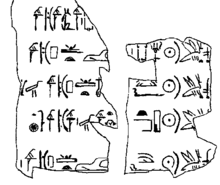Sihathor
| Sihathor | ||||||||||||||||||||||||||||||||||||||||
|---|---|---|---|---|---|---|---|---|---|---|---|---|---|---|---|---|---|---|---|---|---|---|---|---|---|---|---|---|---|---|---|---|---|---|---|---|---|---|---|---|
| Sahathor, Menuazra[1] | ||||||||||||||||||||||||||||||||||||||||
 Sihathor's name on the Turin canon (second row from bottom) | ||||||||||||||||||||||||||||||||||||||||
| Pharaoh | ||||||||||||||||||||||||||||||||||||||||
| Reign | less than a year, "[...] months and 3 days" as a coregent with Neferhotep I[1] | |||||||||||||||||||||||||||||||||||||||
| Coregency | Neferhotep I | |||||||||||||||||||||||||||||||||||||||
| Predecessor | Neferhotep I | |||||||||||||||||||||||||||||||||||||||
| Successor | Sobekhotep IV | |||||||||||||||||||||||||||||||||||||||
| ||||||||||||||||||||||||||||||||||||||||
| Father | Haankhef | |||||||||||||||||||||||||||||||||||||||
| Mother | Kemi | |||||||||||||||||||||||||||||||||||||||
| Burial | likely intended to be in Abydos close to those of his brothers | |||||||||||||||||||||||||||||||||||||||
| Dynasty | 13th dynasty | |||||||||||||||||||||||||||||||||||||||
Menwadjre Sihathor was an ephemeral ruler of the 13th Dynasty during the late Middle Kingdom. Sihathor may never have enjoyed an independent reign, possibly only ruling for a few months as a coregent with his brother Neferhotep I.
According to Egyptologist Kim Ryholt, Sihathor died in 1733 BC[2] while Detlef Franke dates his short reign to 1694 BC.[3] His tomb is likely to be the unfinished one located between the tombs of his brothers S9 and S10, in Abydos.
Attestations
[edit]According to the latest reading of the Turin canon by Ryholt, Sihathor is recorded there on column 7, line 26 (Gardiner col. 6, line 26).[2] Sihathor is attested on two statues from the Hekaib sanctuary in Elephantine as a "king's son", which is here an honorary title referring to his brother Neferhotep I being king.[2] Two rock inscriptions from Philae and Sehel Island further mention Sihathor as a brother to Neferhotep I.[2] According to Ryholt and Stephen Quirke, Sihathor is also attested as a king on a steatite cylinder seal, now in the Petrie Museum (UC1157), and a bead of unknown provenance, now in the Brooklyn Museum.[1][2][4] A few further seals mentioning a king's son Sihathor are known, but Ryholt concludes that they may correspond to another Sihathor.[2] Finally, Vivian Davies points to the existence of a statue of Sihathor made after his death and where he is only given the title of "king's son".[5]
Family
[edit]
The family of Sihathor is known thanks to the rock inscriptions of Philae and Sehel made by his brother Neferhotep I. Sihathor's father is thus known to be Haankhef, his mother was Kemi and his brothers were Neferhotep I and Sobekhotep IV, the later of whom eventually succeeded him on the throne.[2]
Tomb
[edit]The Egyptologist and archaeologist Josef W. Wegner of the University of Pennsylvania has led excavations of the tomb and funerary complex of Senusret III in Abydos as well as of the surrounding necropolis. This necropolis was found to comprise royal tombs dating to the Second Intermediate Period as well as from the earlier late Middle Kingdom. Two large tombs in particular, S9 and S10 are now believed to belong to Sihathor's pharaoh brothers, Neferhotep I and Sobekhotep IV. Indeed, evidences gathered from the neighbouring tombs reveal that a king Sobekhotep was buried in S10, who must be Sobekhotep IV given the size of the tomb, its general datation and location in Abydos. By extension, S9 is likely to belong to Neferhotep I.[7][8]
These attributions are crucial for locating Sihathor's tomb, as indeed Wegner has found an unfinished royal burial at the immediate north-east of S10, east of S9. According to him, its position suggest very strongly that it was intended for Neferhotep's chosen heir Sihathor. The burial seems to have been abandoned at the death of its intended owner, its massive granite sarcophagus reused at a later time, during the chaotic Second Intermediate Period.[9]
References
[edit]- ^ a b c Darrell D. Baker: The Encyclopedia of the Pharaohs: Volume I - Predynastic to the Twentieth Dynasty 3300–1069 BC, Stacey International, ISBN 978-1-905299-37-9, 2008, p. 430
- ^ a b c d e f g K.S.B. Ryholt, The Political Situation in Egypt during the Second Intermediate Period, c.1800–1550 BC, Carsten Niebuhr Institute Publications, vol. 20. Copenhagen: Museum Tusculanum Press, 1997, excerpts available online here
- ^ Thomas Schneider: The Relative Chronology of the Middle Kingdom and the Hyksos Period (Dyns. 12–17), in: Erik Hornung, Rolf Krauss, David A. Warburton (editors): Ancient Egyptian Chronology (= Handbook of Oriental studies. Section One. The Near and Middle East. vol 83). Brill, Leiden/Boston 2006, ISBN 978-90-04-11385-5, pp. 168–196.
- ^ Picture of the cylinder seal
- ^ Vivian Davies: A Statue of the King's Son, Sahathor, from Thebes, in: Stationen Beiträge zur Kulturgeschichte Ägyptens Rainer Stadelmann editor, Heike Guksch, Daniel Polz, pp. 177 - 179, ISBN 3-8053-2526-6
- ^ Flinders Petrie: Scarabs and cylinders with names (1917), available copyright-free here, pl. XVIII
- ^ Wegner, Josef W. (2015). "A royal necropolis at south Abydos: New Light on Egypt's Second Intermediate Period". Near Eastern Archaeology. 78 (2): 68–78. doi:10.5615/neareastarch.78.2.0068. S2CID 163519900.
- ^ Wegner, J.; Cahail, K. (2015). "Royal Funerary Equipment of a King Sobekhotep at South Abydos: Evidence for the Tombs of Sobekhotep IV and Neferhotep I?". JARCE. 15: 123–164. doi:10.5913/jarce.51.2015.a006 (inactive 1 November 2024).
{{cite journal}}: CS1 maint: DOI inactive as of November 2024 (link) - ^ Josef W. Wegner, lecture at the University of Chicago Oriental Institute. On Youtube The Pharaohs of Anubis-Mountain, 28 October 2015.
